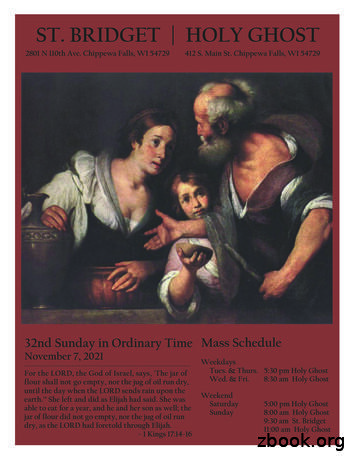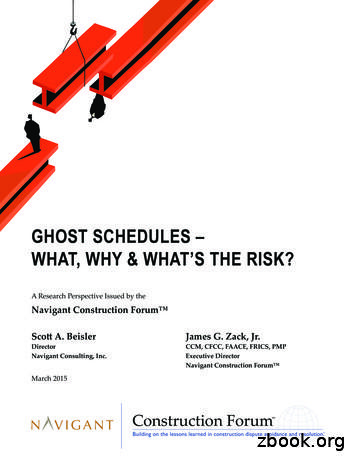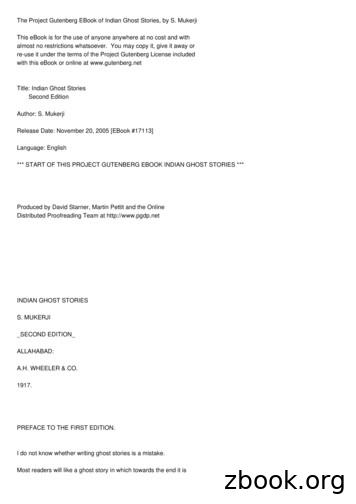Ghost Peak: Practical Distance Reduction Attacks Against HRP UWB Ranging
Ghost Peak:Practical Distance Reduction Attacks Against HRP UWB RangingPatrick Leu1,* , Giovanni Camurati1,* , Alexander Heinrich2 , Marc Roeschlin1 , Claudio Anliker1 , MatthiasHollick2 , Srdjan Capkun1 , and Jiska Classen21 ETHZurichDarmstadt* Authors contributed equally to this research2 TUAbstractWe present the first over-the-air attack on IEEE 802.15.4zHigh-Rate Pulse Repetition Frequency (HRP) Ultra-WideBand (UWB) distance measurement systems. Specifically, wedemonstrate a practical distance reduction attack against pairsof Apple U1 chips (embedded in iPhones and AirTags), aswell as against U1 chips inter-operating with NXP and QorvoUWB chips. These chips have been deployed in a wide rangeof phones and cars to secure car entry and start and are projected for secure contactless payments, home locks, and contact tracing systems. Our attack operates without any knowledge of cryptographic material, results in distance reductionsfrom 12 m (actual distance) to 0 m (spoofed distance) withattack success probabilities of up to 4 %, and requires onlyan inexpensive (USD 65) off-the-shelf device. Access controlcan only tolerate sub-second latencies to not inconveniencethe user, leaving little margin to perform time-consuming verifications. These distance reductions bring into question theuse of UWB HRP in security-critical applications.1IntroductionUltra-Wide Band chips that measure distance are being massively deployed in smartphones, cars, and other products[5, 32, 52]. Applications range from entry and start systems incars to mobile payments, contact tracing, spatial awareness,and indoor localization. In addition to enhanced precisioncompared to more traditional signal strength based ranging,UWB aims to provide security against relay and distance reduction attacks [23], which have been used in practice for carthefts and attacks on contactless payments [16, 33, 59].The recently adopted IEEE 802.15.4z standard [4] aims toaddress known distance reduction attacks. It introduces tworanging modes: Low-Rate Pulse Repetition Frequency (LRP)and High-Rate Pulse Repetition Frequency (HRP). Althoughboth modes are used in automotive applications, primarily forPassive Keyless Entry and Start (PKES) systems [5,11,17,56],HRP has seen adoption in Apple iPhones and AirTags, as wellas Samsung phones and SmartTags [10, 51, 55]. Despite itsstandardization and deployment, no public example implementations or standardized algorithms for security-relevantfunctionality exist. IEEE 802.15.4z focuses on message formats without mandating in detail how ranging is done andprotected at the endpoints.This paper demonstrates the first practical over-the-air distance reduction attack against the UWB IEEE 802.15.4z HRPmode. Even though HRP security has been recently studied,these studies were done in simulations [58]. We refine existingattacks, introduce a new one, and demonstrate their feasibilityin practical settings with Apple U1 (iPhone/AirTag/HomePod), NXP Trimension SR040/SR150, and Qorvo DWM3000chips. Our attack enabled a successful distance reduction ofup to 12 m with an overall success rate of 4 %, which is higherthan what is generally accepted for relevant applications. Typically, false acceptance rates are 1/220 for gate access controland 1/248 for mobile payments, such that it would take days toyears until a fake measurement gets accepted.Manufacturers advertise some of the evaluated chips assecure ranging capable [38]. We performed our tests using theconfigurations that are openly accessible on these chips. Sincesecurity algorithms and parameters are not public in the chipsthat we tested (Apple, NXP, Qorvo), it is hard to determineif these systems can be configured differently and if thesealternative configurations would be vulnerable to our or otherattacks. Additionally, the past has shown that undisclosedwireless protocols can signify security-by-obscurity solutions[28, 60]. Prior work [58] further suggests that making HRPranging both secure and reliable is likely hard.The deployment and use of UWB will presumably increasein the future. The FiRa consortium [18] has been foundedto contribute to the development and widespread adoptionof UWB technologies in the context of secured fine rangingand positioning. The Car Connectivity Consortium recentlypublished Digital Key Release 3.0, enabling PKES via UWBin combination with Bluetooth Low Energy [13]. At least onecar manufacturer has already announced that it will supportthe iPhone as an access token for PKES, citing UWB as a
ranging mechanism [11]. Since UWB as an access system isa new protocol, it might take time until malicious actors canfully understand and bypass security checks [61]. However,systems in cars and other areas related to access control haveto be secure for decades after initial deployment. Therefore,we see this work as another step towards a better understanding of the security of UWB HRP.In summary, we make the following contributions: We introduce the first practical distance reduction attack on IEEE 802.15.4z HRP. This amendment definescryptographically generated high-rate pulse sequencesfor Time of Arrival (ToA) measurement, whose unpredictability is supposed to prevent distance reduction bypreventing the attacker from transmitting valid signalsearlier than the victim. Our attack operates in a blackbox manner and assumes neither knowledge of cryptographic material shared between the attacked devices noraccess to (randomized) ranging message content beforemessages are transmitted. This attack not only validatesobservations from simulation-based studies of HRP butalso introduces a novel attack dimension—it selectivelyvaries the power of the injected packet per packet field.The power level is independently adjusted for differentfields so that the injected signal is neither perceived as anadditional packet nor as jamming the legitimate one. Ourattack can therefore also be seen as a type of selectiveovershadowing. We implement our attack on inexpensive (USD 65),commercial off-the-shelf components and demonstrateit on Apple iPhones and AirTags (U1 chip) and oniPhones interoperating with NXP SR040/SR150 andQorvo DWM3000 UWB chips. We evaluate our attackthrough a series of experiments and show that the attacker can reduce the measured distances from 12 m to0 m (measured distance). During normal execution, themeasurement error is between 10 cm and 20 cm. With asuccess rate as high as 4 %, our attack suffices to deceiveranging systems that rely on single HRP measurements. We discuss the implications of our results to different applications and use cases and the applicability of differentmitigation techniques in practical settings. We responsibly disclosed our findings to Apple, andNXP, and are in the process of disclosing to Qorvo.The rest of the paper is organized as follows. In Section 2,we provide background on UWB secure distance measurements. In Section 3, we present our attack. We discuss ourexperimental results in Section 4. Finally, we reflect on thesecurity of HRP UWB in Section 5 and compare it to relatedwork in Section 6 before concluding in Section 7.2BackgroundIn this chapter, we provide the necessary background on Timeof-Flight (ToF) HRP UWB. We first introduce the conceptof ToF ranging and show how HRP uses cross-correlation todetermine the ToF before explaining security considerationsbehind HRP. Finally, we provide a brief overview of availableHRP chips and products.2.1UWB Secure RangingThe simplicity and practicality of relay attacks on PKES systems [16, 23, 59] urged a paradigm shift in secure ranging.Utilizing a signal’s ToF is promising since a relay can onlyincrease the ToF and, thus, the measured distance. However,research in this field has shown that such systems can still bevulnerable to more sophisticated attacks, such as Cicada [43]or Early Detect/Late Commit (ED/LC) [41].UWB aims to implement secure ranging, includingphysical-layer security [19]. IEEE 802.15.4 proposes twomodes for UWB ranging named LRP and HRP. They areboth subject to stringent power limitations, as their channelsoverlap with frequency bands used by existing technologies,such as Wi-Fi or cellular networks. While LRP approachesthe power limit by using fewer but stronger pulses (each individually ‘visible’ to the receiver), HRP relies on a largernumber of weaker pulses (which cannot be individually decoded in most environments by the receiver). This differencein design has consequences; while the security of LRP iseasy to demonstrate, the resilience of HRP against reductionattacks is an open research question. Recent in-simulationanalysis has shown that HRP might be hard to configure tobe both performant and secure [58].2.1.1Two-Way RangingThe IEEE 802.15.4 standard defines three different ranging and localization methods, namely Single-Sided TwoWay Ranging (SS-TWR), Double-Sided Two-Way Ranging(DS-TWR), and Time Difference of Arrival (TDOA); ourwork focuses on SS-TWR and DS-TWR.SS-TWR is depicted in Figure 1a, which shows how ToFfor the distance calculation can be determined by subtractingTreply , the processing time of the responder, from Tround , thetotal round trip time measured by the initiator. Dividing theresult by two yields an estimation of the propagation delayT̂prop , or the ToF required by the signal to cover one way.However, this result may be affected by a possible clock frequency offset between initiator and responder. If the initiatorcan measure this offset, it can compensate for it and improvethe measurement.DS-TWR, as shown in Figure 1b, mitigates the clock offset by transmitting more messages. DS-TWR comprises twoSS-TWR exchanges in opposite directions. Treply and Tround
�prop T̂prop 1/2(Tround Treply )tTround1 ·Tround2 Treply1 ·Treply2Tround1 Tround2 Treply1 Treply2(b) Double-sided two-way ranging with three messages.(a) Single-sided two-way ranging.Figure 1: The principle of two-way ranging [4].are measured with both devices/clocks, significantly reducingerrors induced by clock offset and drift. DS-TWR is optimized by simultaneously using the response message of thefirst exchange as the request message of the second, thusreducing the procedure to three ranging messages. The derivation of the propagation time formula can be found in [36].fore, a momentary output of the correlation is non-conclusive,and instead, the Channel Impulse Response (CIR), i.e., thecorrelation output over time, must be inspected. The CIRgreatly supports the search for a known template in the received signal and can determine the precise arrival time of apacket. The CIR can be estimated as follows: gloc 12.1.2CIR[t] (gloc s)[t] Receiver Design and Cross-Correlation gloc [m] · s[m t]m 0Most RF communication technologies rely on crosscorrelation to detect the presence of an incoming message. InUWB, the receiver constantly scans the acquired signal for astatic (pre-negotiated) preamble using a local template. Thereceived signal is digitized and recorded as I/Q samples fedinto a correlator. If the output exceeds the level for noise by acertain amount, the receiver concludes that a packet must bepresent and analyzes the signal further.In practice, this process has to be optimized to cope withchannel distortions, most notably multi-path fading. Duringtransit, objects in the vicinity reflect the signal, which createscopies of the signal that are slightly delayed in time, as shownin Figure 2. Those copies are superimposed onto the originalsignal, causing constructive or destructive interference. There-where s[·] is the complex and time-discrete received signal,gloc [·] is the template of the expected signal, and denotescross-correlation.As shown in Figure 3, HRP UWB ranging relies heavilyon cross-correlation, to detect and determine the arrival timesof preamble and a Scrambled Timestamp Sequence (STS).We explain STS in the next section. A UWB receiver crosscorrelates the incoming signal with a template (e.g., a knownsequence) for the preamble and, if present, also with a knowntemplate for the STS. High correlation values imply similarities between the template and the received signal. However,the CIR only shows a single distinct peak in perfect conditions.Due to multi-path, the CIR often shows a profile containingseveral peaks, and it is not straightforward to identify the firstpeak/path that reflects the actual physical distance. Construc-PowerRXLoSNLoStTXLeading EdgetRXFigure 2: In a Non-Line-of-Sight (NLoS) scenario, the receiver needs to detect the arrival time of the early Line-ofSight (LoS) copy (leading edge).Search WindowFirst PathStrongest PathCIR[t]NLoSPPower ThresholdAmplitudeLoStFigure 3: The CIR is calculated based on the received signaland a local template of the expected signal. A correlation peakindicates high similarity. However, with multi-path effects,there are multiple peaks. The receiver identifies the first LoSpath, e.g., by searching back in time from the strongest peak.
tive and destructive interference can lead to a CIR where thefirst path emerges as a peak with an amplitude significantlybelow the maximal value. To be precise, even in absence ofmulti-path, an additional source of noise in the CIR is thenon-ideal (auto)correlation of the STS. Ideally, we would expect a CIR peak only when incoming STS and local templateare perfectly aligned in time. In practice, if the two copiesare shifted by a multiple of the pulse rate, they might stillexhibit some similarity (some of the bits will randomly be thesame), causing additional noise in the form of (significantly)smaller side lobe peaks. Channel and receiver noise make thesearch for the first path and thus the correct distance evenmore challenging.2.1.3High-Rate Pulse Repetition (HRP)HRP mode of IEEE 802.15.4 uses a high pulse repetition frequency of 64 MHz. The spacing between pulses is narrowand, to meet stringent restrictions on power spectral density( 41.3 dBm/MHz) [1], the power per pulse is low, in the order of 80, instantaneous dBm (at the antenna port). Theinformation elements of a packet are either encoded withBurst-Position Modulation (BPM) using Binary Phase ShiftKeying (BPSK) or just BPSK symbols. In BPM-BPSK, asymbol can encode two bits by varying the position of theburst and the polarity of the pulses, while in BPSK, a positivepolarity pulse encodes a bit of value zero, and a negative polarity pulse (180 phase shift) encodes a bit of value one. MostUWB channels are 499.2 MHz wide, which is the bandwidthused by all our tested devices. At 499.2 MHz, the duration ofa pulse is in the order of 2 ns.HRP PHY Packet It is essential for the attacks describedin this paper to understand the HRP packet construction andpulse sequence. Figure 4 shows the different segments thatconstitute an HRP ranging message using an STS. The packetpreamble is used to detect the presence of a ranging message. The STS contains a cryptographically-secure pseudorandom bit sequence for security purposes, and the data segment may be used to transmit additional information. TheStart-of-Frame Delimiter (SFD) should be taken as a reference to calculate the propagation delay, and the PHR carriesthe physical header of the packet. We refer interested readersto the official release of the IEEE 802.15.4 standard for a moredetailed description of the PHY [2].Scrambled Timestamp Sequence (STS) The preambleis a pre-defined and static sequence of pulses representing 1, 0, and 1, modulated using a ternary code, i.e., positive,negative and no pulse. In contrast, the STS consists of BPSK-modulated pulses representing 1 and 1. The bit sequencein the STS is the output of a pseudo-random generator andderived as outlined in Figure 5. The ranging devices need toagree on a 128-bit key, e.g., by using an out-of-band channel, before the UWB ranging operation can commence. Afresh STS is generated for every ranging message, as theST S V Counter increases with every packet. The ranging devices know the expected STS bit sequence in advance, andthey can create a local template to detect the incoming STSusing cross-correlation as described in Section 2.1.2. Sincethe STS contents cannot be predicted, it is theoretically impossible for an external source to emit a signal that arrives at thetargeted device earlier in time and still contains the legitimateSTS; only the legitimate device knows which data/signal tosend. As a result, ranging devices can base the ToA of thepacket on the arrival time of the STS and thereby guaranteethat no external adversary reduces the measured distance byadvancing the received signal in time. Moreover, it is alsoimpossible to react to isolated pulses and send those earlier intime since the BPSK pulses as part of the STS are only about2 ns long. An adversary cannot acquire the polarity of a singlepulse in sufficient time, which makes any replay or ED/LCattack physically impossible. In any case, advancing pulseswould only yield a 2 ns reduction at the maximum, translatingto less than 60 cm in distance.Channel Distortion and Multi-Path Fading UWB ranging packets are subject to channel noise and multi-path fading,rendering the (direct) demodulation of single pulses of theSTS intricate and in some channel conditions impossible. At a64 MHz pulse repetition frequency, the pulse spacing is in theorder of 16 ns, which is shorter than the typical channel delayspread. As a consequence, inter-pulse interference and multipath fading effects make separate pulses unrecognizable. Towork around this, HRP detects STS by cross-correlating thereceived signal with the expected STS, similar to preambledetection. Although cross-correlation is a powerful tool todetermine the presence of the STS, the computed ChannelImpulse Response (CIR) often shows a profile that containsmultiple correlation peaks, and pinpointing the exact arrivaltime remains challenging. The CIR is a superposition of crosscorrelation side peaks and weak early path correlation peaks.STS V UpperSFDSTSPHRData payloadFigure 4: Example format of an HRP packet [4]. The fieldlengths and their order depend on the configuration.128-bit KeyKey128-bit Value VDataAES-128STS[0]PreambleSTS V Counter n.STS[n-1]STS[n]STS[n 1].STS[31]Figure 5: Cryptographically secure STS generation with AESin counter mode. Each iteration results in a random 128-bitblock. The STS V Counter is incremented for every iteration.The entire STS comprises 32 blocks, or 4096 bits [4].
Figure 3 shows two pulses after reception (in red) and thetemplate used by the receiver (in grey). The resulting CIR(in blue) exhibits multiple peaks. The highest peak does notnecessarily correspond to the LoS path of the signal. Evenbefore the strongest correlation value, any HRP receiver mustcheck for additional peaks within a specific time window.Such a peak might suggest an earlier but weaker copy of thesignal, which belongs to a shorter path. By using this path asa reference, the receiver can compute a more accurate rangingresult. Details on how the time of arrival of the STS is determined are not specified in the standard for HRP. At the timeof writing, the exact procedure remains protected intellectualproperty for all commercially available HRP transceiver chipswe have evaluated.2.1.4Ideal versus Real Security GuaranteesIf every pulse contained in the STS would be demodulated,absent of noise and channel effects, the receiver could verifyevery single bit in the sequence. However, in HRP UWB, the4096 bit long STS does not result in 4096 verifiable bits. First,the entropy of the key used for AES in counter mode is only128 bits, see Figure 5. Second, since the STS is verified bycorrelation instead of single pulse demodulation, any securityguarantee is given by the significance level of the early peakcompared to the overall cross-correlation profile. Non-idealcross-correlation properties of random sequences, such as theSTS, can cause side-lobes in the correlation and play a minorrole.A bit-wise STS comparison instead of cross-correlationwould have to allow for transmission errors, which naturallyhappen in NLoS scenarios. IEEE 802.15.4z does not specifywhether the STS should be compared bit-wise after the correlation operation. Even if a vendor implements additionalchecks, they need to account for bit flips and choose a threshold that significantly impacts on the security provided by theSTS.2.2Commercial HRP UWB ChipsAs of now, only a few vendors offer HRP transceiver chips,despite the fact that HRP-based location and tracking tagshave entered the consumer market at scale [32] and automotive manufacturers are planning to release cars featuringPKES systems built on top of HRP chips, such as the BMWiX and the Genesis GV60 models [11, 52]. The FiRa consortium considers HRP viable for both consumer-grade andsecurity-critical applications alike [19].Apple has a diverse UWB software and hardware stack.Different versions of the Apple U1 chip have been releasedin recent products, such as the iPhone (since iPhone 11), theHomePod mini, the Apple Watch (since Series 6), and eventhe USD 30 AirTag. On the iPhone, Apple integrated UWBinto AirDrop with iOS 13 [40], using Angle of Arrival (AoA)measurements to simplify the location of devices and enhanceuser experience. With iOS 14, they introduced the Nearby Interaction framework, exposing a selected set of UWB-basedranging functionality to application developers [30]. A compatibility mode for third-party accessory support has beenavailable since the release of iOS 15 [31]. However, detailsabout the compatibility mode configuration parameters areonly available to Made for Apple (MFi) program members.NXP advertises their Trimension chip series for secureranging and precise positioning [38]. Development kits existfor the SR150 and SR040 [56]. Our analysis showed thatseveral Samsung products, for example, the SmartTag andphones starting from Samsung Note20 Ultra [55], containNXP chips to enable ranging and improve Point to Share [50]data transfers. Examples for cars that comprise NXP chipsare upcoming BMW and VW models [53, 54], whereas VWseems to incorporate LRP chips for PKES use cases [5].Qorvo, also known as Decawave before their acquisition [47], manufactures the DW3000 chip series. These chipsare interoperable with the Apple U1 chip [44]. Nevertheless,to the best of our knowledge, there are no commercially available products that use the DW3000 series and are compatiblewith Samsung or Apple consumer devices. Qorvo also offerstwo development kits: DWM3000EVB, an Arduino-baseddevelopment board [45], and DWM3001CDK, an integratedboard that contains an nRF52833 with Bluetooth 5.2 [46].3A Practical Distance-Reduction AttackIn the following, we explain our attacker model, the theoretical working principle of our attack, including boundaries ofdistance reduction, and the attack algorithm and setup.3.1Attacker Model and Attack OverviewWe consider an attacker that is trying to reduce the distancemeasured between two HRP UWB devices.1 E.g., an attackertrying to unlock and start a car by tricking it into believingthat the legitimate owner’s car keyfob is near. Even a distancereduction in the order of a few meters can have a severeimpact, e.g., if the car is parked in front of the legitimateowner’s house.We consider a black-box attacker with the following limitations. The attacker has no access to any secrets sharedbetween victim devices and cannot predict message field contents that are assumed to be unpredictable in HRP UWB;i.e., the attacker cannot predict the Scrambled Timestamp Sequence (STS). Unable to guess the STS, our attacker cannotsimply send a valid packet to advance the message time ofarrival and therefore reduce the distance. The attacker can1 We do not focus on bearing, which is not covered by IEEE 802.15.4z, isnot protected in current implementations, and would likely be vulnerable to
The deployment and use of UWB will presumably increase in the future. The FiRa consortium [18] has been founded to contribute to the development and widespread adoption of UWB technologies in the context of secured fine ranging and positioning. The Car Connectivity Consortium recently published Digital Key Release 3.0, enabling PKES via UWB
are a stupid ghost. The least a ghost can do is to read a man’s thoughts. However , a worthless ghost like you is better than no ghost. The fact is, I am tired of wrestling with men. I want to fight a ghost”. The ghost was speechle
Nov 07, 2021 · Tues. & Thurs. 5:30 pm Holy Ghost Wed. & Fri. 8:30 am Holy Ghost Weekend Saturday 5:00 pm Holy Ghost Sunday 8:00 am Holy Ghost 9:30 am St. Bridget 11:00 am Holy Ghost
Gerald Massey's “ Book of.the Beginnings,” 338, 415 Ghost at Noon-day, 321 Ghost—The Gwenap, 268 Ghost—The Micklegate, 23, 60 Ghost-seeing, in North American Review, 307 Ghost, Solitary Visit by a, 367 Ghosts by Day, 350 Ghosts in Africa, 33 Ghosts, The Truth about, 325, 343 Ghosts,
The term "ghost kitchen" has surged in popularity over the past year. In this rst section of The Beginner's Guide to Ghost Kitchens, we outline what a ghost kitchen is and what sets it apart from the rest of the dining industry. A ghost kitchen is a food facility that operates exclusively for online and delivery orders.
the term Ghost Schedule. It is prudent to discuss what a Ghost Schedule is not. A contractor's Ghost Schedule is not a schedule maintained in lieu of submitting a baseline schedule and schedule updates per the contract. Even if the contractor is using a Ghost Schedule, it still must comply with the contract's scheduling requirements. An .
Green: ghost solid. 4 The Ghost SPH Method 4.1 Algorithm Overview We solve the particle deficiency at boundaries and eliminate arti-facts by (1) dynamically seeding ghost particles in a layer of air around the liquid with a blue noise distribution, (2) extrapolating the right quantities from the liquid to the air and solid ghost parti-
Most readers will like a ghost story in which towards the end it is. found that the ghost was really a cat or a dog or a mischievous boy. Such ghost stories are a source of pleasure, and are read as a pastime and are often vastly enjoyed, because though the reader is a bit afraid
Most communities claim a few ghost stories. Ask students to use library resources or websites to identify a ghost story that is unique to their community or state. Then have the students write a one-page paper that identifies the ghost and explains when and why the ghost appears.























